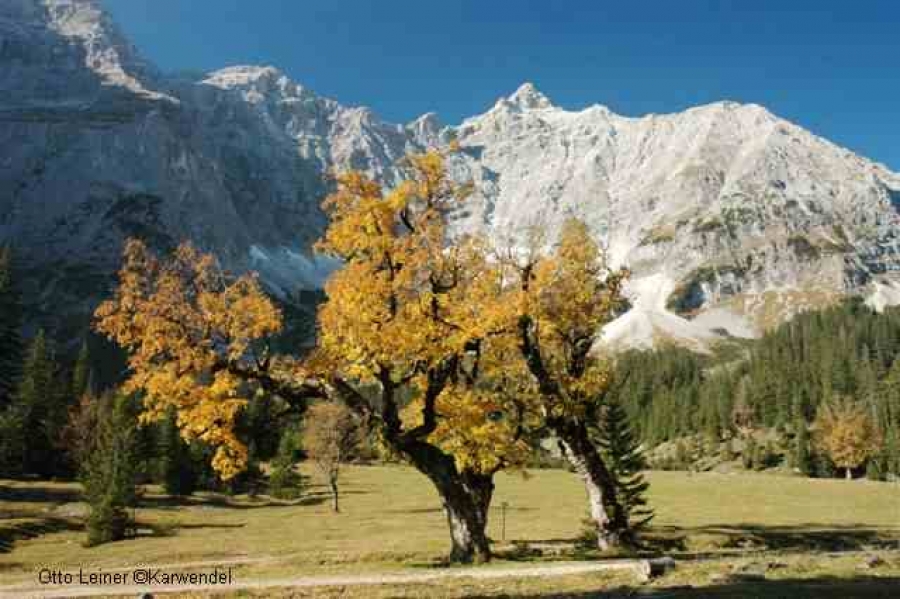The Alpine Park Karwendel encompasses almost all of the Karwendel range. Extending over 727 km², the park is the largest protected area in the state of Tyrol and Austria's largest nature park. The area’s exceptional conservation value was recognised very early on. Tyrol’s oldest protected area first came into being when the central section of the Karwendel massif was made a conservation area back in 1928. The climate and topography have endowed the Karwendel range with an unusually high number of natural habitats such as ancient woodlands and wild rivers (Isar and Rißbach).
The massif is also home to a wide variety of species. Many typical Alpine flora and fauna are very common here, including golden eagles, sandpipers and German tamarisk (Mycaria germanica). The Karwendel range has been a destination for Alpine tourists for over 130 years and receives around one million visitors every year.
Traditional farming practices – including Alpine dairy farming, forest management and hunting –play a vital role and have been an integral part of the region's identity for centuries.
The role of the park management
The park management body is an essential factor in making formal conservation commitments issues a reality on the ground for regional stakeholder. To this end, the Alpine Park Karwendel Association (Verein Alpenpark Karwendel) was created in January 2008, a body which brings together the federal state of Tyrol, all the relevant local authorities, tourism federations, the Austrian Federal Forests service, chambers of agriculture and the Austrian Alpine Club. The park’s activities focus on:
- Conservation
- Visitor facilities and management
- Environmental education and natural sciences
The top priority for conservation is maintaining natural rhythms and diversity in the Alps. Projects designed to do that include establishing reserves of ancient woodland, maintaining natural wild watercourses, returning the Karwendel marshes in the Achen valley to their natural state, and the Rißtal sandpiper conservation programme.
Interactions between visitors and the park are intended to develop awareness and a love of Nature, thereby ensuring its preservation. Visitors can learn about the Alpine Park Karwendel at the Hinterriß visitor centre and can also take part in a variety of organised activities. Four park rangers are always out and about in the park during the summer with a view to encouraging contact between visitors and locals.
A wide-ranging environmental education programme has been developed as part of the park's natural sciences education activities, with courses lasting anything from half a day to five days. The courses look at key issues in the Karwendel park: biodiversity, water, life in the high mountains, Alpine dairy farming, forest management and more.
|
Name of protected area |
Karwendel Alpine Park
|
|
Managing enterprise (if different)
|
Karwendel Alpine Park Association
|
|
Country
|
Austria
|
|
Area (ha)
|
72 700
|
|
Year of creation
|
17/02/1928 – 1st protection order; 1995 – Natura 2000; 2010 - The alpine Park got the label "Nature Park"
|
|
UICN category
|
3 natural reserves, 6 protected areas, 2 calm zones
|
|
Legal basis
|
Association
|
|
Included regions
|
Tyrol/ Austria
|
|
Number of municipalities
|
15
|
|
Highest point (m)
|
About 800m
|
|
Lowest point (m)
|
Birkkarspitze (2.749 m)
|
|
Population
|
The largest part of the territory is uninhabited, the park counts 46 permanent habitants; it has about 1 million visitors per year
|
|
Forest surface
|
50%
|
|
Glacier surface
|
0%
|
|
Pasture surface
|
101 mountain pastures (about 10.000 ha of alpine pasture surface)
|
|
Prevailing landscape types
|
Mountain pastures, some areas of mountain torrent are very wild (Isar, Rissbach), mixed mountain forests.
|
|
Emblematic fauna
|
Eagles, chamois, common sandpiper, 2.200 caleoptera species (beetle), 700 butterfly species.
|
|
Emblematic flora
|
German Tamarisk, sycamore maple, tipical alpine flora with numerous species of gentiana and orchid families such as the "lady's slipper orchid"
|
|
Major touristic attractions
|
Great and small Ahornboden, Isar spring (Hinterautal), Laliderer wall (Hinterriß), Hafelekar - a "window" which looks out onto the Karwendel mountains (Innsbruck), Wolfsklamm gorge (Stans), Halltal (Absam)
|
|
Information center(s) (quanitity, name, topics)
|
Hinterriß park's house with pedagogical spaces on subjects such as hunting activities, fauna, geology, water, history and alpinism.
|
|
Internet site
|
www.karwendel.org
|
|
Number of employees
|
3 - 4 personnes
|
|
Access
|
By car: since Innsbruck take the A12 (also called E60, see E45) in direction of Salzburg, issue Jenbach then follow Achenseerstraße. Go on in the direction of Maurach s/Achensee, then take the B181 direction Germania, cross Bavaria (the road number is B307), follow in the direction of Lenggries. Arrived at Sylvensteinspeicher, turn to the left in the direction of Fall, Vorderis (always on 307). At Vorderriss, take the left in the direction of hinterriss and go on 10km. The park’s house is in the entry of the village, just after the former customs, on the right. |




